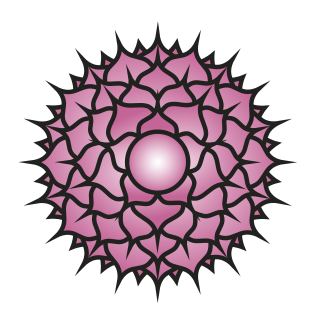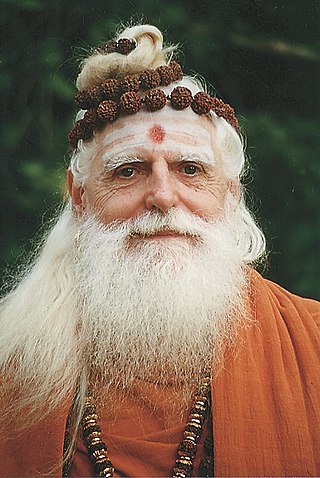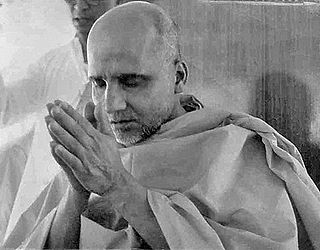Related Research Articles

Sahasrara or the crown chakra is considered the seventh primary chakra in some yoga traditions. The chakra is violet in colour.

Self-Realization Fellowship (SRF) is a worldwide, spiritual organization founded by Paramahansa Yogananda in 1920. Before coming to the United States, Yogananda began his spiritual work in India in 1917 and named it Yogoda Satsanga Society of India (YSS). He founded SRF in 1920 and in 1925 the Mount Washington property became the international headquarters for SRF and YSS, located in Los Angeles, California. Before his return visit to India in 1935, he legally incorporated SRF in the United States as a non-profit religious organization. He only created SRF as the organization to carry on his work - to care for and disseminate his teachings.

Sivaya Subramuniyaswami was an American Hindu religious leader known as Gurudeva by his followers. Subramuniyaswami was born in Oakland, California and adopted Hinduism as a young man. He was the 162nd head of the Nandinatha Sampradaya's Kailasa Parampara and Guru at Kauai's Hindu Monastery which is a 382-acre (155 ha) temple-monastery complex on Hawaii's Garden Island.

Sivananda Saraswati was a yoga guru, a Hindu spiritual teacher, and a proponent of Vedanta. Sivananda was born in Pattamadai, in the Tirunelveli district of Tamil Nadu, and was named Kuppuswami. He studied medicine and served in British Malaya as a physician for several years before taking up monasticism.

Satyananda Saraswati, was a Sanyasi, yoga teacher and guru in both his native India and the West. He was a student of Sivananda Saraswati, the founder of the Divine Life Society, and founded the Bihar School of Yoga in 1964. He wrote over 80 books, including the popular 1969 manual Asana Pranayama Mudra Bandha.
Bindu is a Sanskrit word meaning "point", "drop" or "dot".

Satchidananda Saraswati, born C. K. Ramaswamy Gounder and usually known as Swami Satchidananda, was an Indian yoga guru and religious teacher, who gained fame and following in the West. He founded his own brand of Integral Yoga, and its spacious Yogaville headquarters in Virginia. He was the author of philosophical and spiritual books and had a core of founding disciples who compiled his translations and updated commentaries on traditional handbooks of yoga such as the Yoga Sutras of Patanjali and the Bhagavad Gita for modern readers.

The Divine Life Society (DLS) is a Hindu spiritual organization and an ashram, founded by Swami Sivananda Saraswati in 1936, at Muni Ki Reti, Rishikesh, India. Today Divine Life Society has branches around the world, with the headquarters situated in Rishikesh. Many disciples of Swami Sivananda have started independent organizations in Mauritius, the United States, Australia, Canada, Malaysia, South Africa, South America, and Europe.

Baba Hari Dass was an Indian yoga master, silent monk, temple builder, and commentator of Indian scriptural traditions of dharma and moksha. He was classically trained in the Ashtanga of Patanjali, as well as Kriya yoga, Ayurveda, Samkhya, Tantra, Vedanta, and Sanskrit.

Vishnudevananda Saraswati was an Indian yoga guru known for his teaching of asanas, a disciple of Sivananda Saraswati, and founder of the International Sivananda Yoga Vedanta Centres and Ashrams. He established the Sivananda Yoga Teachers' Training Course, possibly the first yoga teacher training programs in the West. His books The Complete Illustrated Book of Yoga (1960) and Meditation and Mantras (1978) established him as an authority on Hatha and Raja yoga. Vishnudevananda was a peace activist who rode in several "peace flights" over places of conflict, including the Berlin Wall prior to German reunification.
The Shanti Mantras, or "Peace" or Pancha Shanti mantras, are Hindu prayers for peace (shanti) found in the Upanishads. Generally, they are recited at the beginning and end of religious rituals and discourses.

Advait Mat or Paramhans Advait Mat is a cluster of panths in northern India. It was founded by Shri Swami Advaitanand Ji Maharaj (1846-1919) who is also known as Paramhans Dyal Ji Maharaj. He declared Swami Swarupanand Ji Maharaj as his spiritual successor. Swami Swarupanand Ji Maharaj founded more than 300 ashrams with the purpose of disseminating his master's teachings. Swami Swarupanand Ji Maharaj had initiated more than thousand of his disciples into the sanyas. Many of his disciples went on to establish spiritual institutions to spread the same knowledge.

Swami Krishnananda Saraswati was a disciple of Sivananda Saraswati and served as the General Secretary of the Divine Life Society in Rishikesh, India from 1958 until 2001. Author of more than 40 texts, and lecturing extensively, on yoga, religion, and metaphysics, Krishnananda was a prolific theologian, saint, yogi and philosopher.
Yogi Ramsuratkumar was an Indian saint and mystic. He was also referred to as "Visiri samiyar" and spent most of his post-enlightenment period in Tiruvannamalai, a small town in Tamil Nadu which is famous for attracting spiritual seekers worldwide and has had a continuous lineage of enlightened souls. He acknowledges the contribution of three of the most well known saints of his time in his evolution to enlightenment. These individuals were Sri Aurobindo, the founder of Integral yoga, Ramana Maharshi, one of the "spiritual supermen" of his time, and Swami Ramdas, Yogi's eventual guru.

Swami Nigamananda Paramahansa was an Indian yogi, guru and mystic well known in Eastern India. He is associated with the Shakta tradition and viewed as a perfect spiritual master of vedanta, tantra, yoga and prema or bhakti. His followers idealized him as their worshipped and beloved thakura.

Shri Paramhans Swami Advaitanand Ji Maharaj, also known as Shri Paramhans Dayal Maharaj Ji, son of Shri Tulsi Das Ji Pathak, was born in Chhapra City at Saran district, Bihar, India. Shri Paramhans Dayal Maharaj Ji is also known as the "First Spiritual Master" of the [Shri Paramhans Advait Mat]. He initiated the "Second Master", Shri Swami Swarupanand Ji Maharaj in the early 1900s. He was born on the day of Rama Navami and was therefore named as "Ram Yaad ". His father was a famous scholar Pandit Tulsi Pathak. His mother died a few months after his birth and he was brought up by his father's disciple Lala Narhari Prasad. Shri Narhari Prasad arranged for his education. Shri Ramyaad gained good knowledge of Sanskrit, Hindi, and Arabic. At the age of five, his father Shri Tulsiram Ji died.

Tibor Kökény is a Hungarian psychologist and teacher of Yoga in Daily Life System.
Integral Yoga is a system of yoga that claims to synthesize six branches of classical Yoga philosophy and practice: Hatha, Raja, Bhakti, Karma, Jnana, and Japa yoga. It was brought to the West by Swami Satchidananda, the first centre being founded in 1966. Its aim is to integrate body, mind, and spirit, using physical practices and philosophical approaches to life to develop the physical, emotional, intellectual, and spiritual aspects of individuals. The system includes the practices of asana, pranayama, and meditation to develop physical and mental stillness so as to access inner peace and joy, which Satchidananda believed was a person's true nature. It also encourages practitioners to live service-oriented lives.

Siddeshwar Swami was an Indian Hindu Lingayat spiritual leader known for his teachings on yoga and spirituality. Swami was the head of Jnanayogashrama, an ashram in the city of Vijayapura, in the Indian state of Karnataka. He declined the Padma Shri, India's fourth-highest civilian award, when it was awarded to him in 2018. He had earlier declined an honorary doctorate from the Karnatak University.
References
- 1 2 3 Paramhans Swami Madhavananda, Lila Amrit – The Divine Life of Sri Mahaprabhuji, International Sri Deep Madhavananda Ashram Fellowship, Chapter: Paramhans Swami Maheshwarananda, ISBN 3-85052-104-4
- 1 2 Lila Amrit
- ↑ ABC News – Escape, Relax and Recharge on a Yoga Retreat [ permanent dead link ]
- ↑ Swamiji and the Bhajan, ABC Radio National 30 May 2008
- ↑ "The Appearance of Lord Shiva".
- ↑ Paramhans Swami Maheshwarananda , The hidden power in humans, Ibera Verlag, page 251, ISBN 3-85052-197-4
- ↑ Paramhans Swami Madhavananda, Lila Amrit – The Divine Life of Sri Mahaprabhuji, International Sri Deep Madhavananda Ashram Fellowship, page 149, ISBN 3-85052-104-4
- ↑ Paramhans Swami Maheshwarananda , 'The hidden power in humans', Ibera Verlag, page 255, ISBN 3-85052-197-4
- 1 2 Paramhans Swami Maheshwarananda, Yoga in Daily Life – The System, Ibera Verlag, Introduction, page 10, ISBN 3-85052-000-5
- 1 2 Yoga is not a religion
- ↑ Sina Karli (29 May 2006). "Deset posto Hrvata poznaje moju jogu" [Ten percent of Croats are familiar with my yoga] (in Croatian). Nacional. Archived from the original on 13 June 2011. Retrieved 7 July 2012.
- ↑ Conscious Living Radio – Interview
- ↑ Express Nightout (Washington Post) – Come in Peace: Swamiji's Yoga in Daily Life Archived 27 March 2009 at the Wayback Machine
- ↑ YIDL Fellowship
- ↑ http://esango.un.org/civilsociety/showProfileDetail.do?method=showProfileDetails&profileCode=2417 esango.un.org
- ↑ Satellite image
- ↑ Om Ashram
- ↑ "WPS in Bratislava, Slovak Republic, 2007". Archived from the original on 17 July 2008. Retrieved 13 May 2009.
- ↑ WPS in Wellington Archived 14 October 2008 at the Wayback Machine , New Zealand, 2008
- ↑ http://save-birds.com Archived 20 June 2015 at the Wayback Machine
- ↑ Fox TV 2 – Web Extra! Swamiji!
- ↑ "Home". helphospital.org.
- ↑ Millennium World Peace Conference of Religious and Spiritual Leaders Archived 6 January 2009 at the Wayback Machine , New York, 2000
- ↑ Narodne novine
- ↑ Bharat Gaurav